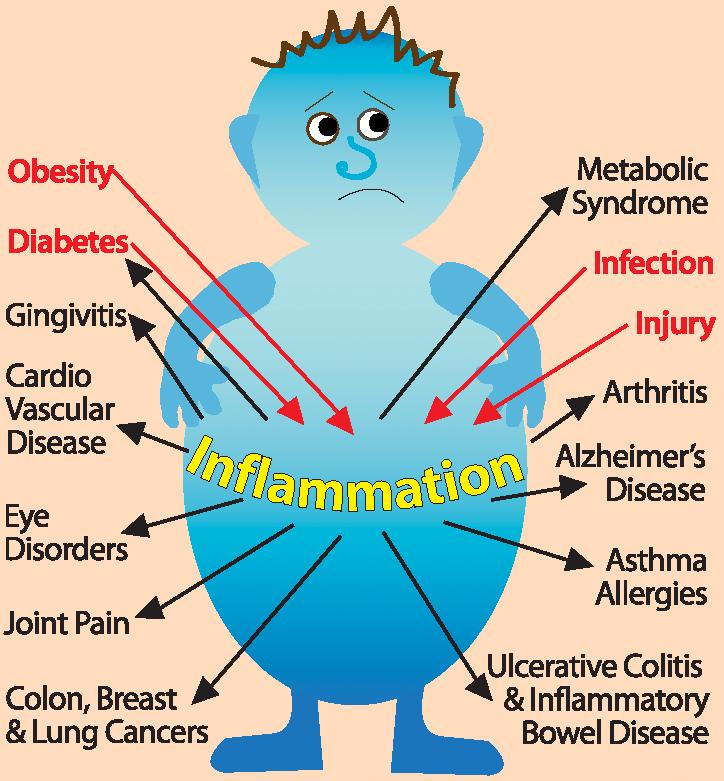As someone who leads the athletic lifestyle, staying active, agile, and strong is of critical importance. You hit the gym on a regular basis in effort to attain these characteristics and would do just about anything you can to ensure you are consistently moving forward.
But, could one factor be limiting your progress without you potentially even realizing it?
Inflammation is a serious problem that impacts far too many people, often silently until the symptoms become severe.
Let’s take a closer look at what inflammation is, why it happens, and how it impacts you and your athletic performance.
What Is Inflammation?
On its own, inflammation isn’t necessarily a bad thing. In fact, inflammation can be a very good thing as it is the body’s natural response to injury or whenever a foreign organism such as a bacteria or virus infects us. For instance, if you twist an ankle while running for instance, there’s a high probability it’ll become inflamed and swollen. Inflammation is occurring and this is helping to speed along the recovery process.
When inflammation takes place, on an internal level, this is your body’s white blood cells and immune system helping to defend against injury or an invading bacteria or virus.
So over the short term, this can actually be a very good thing.
The problem however occurs when inflammation becomes chronic. If your body is chronically inflamed, this is a good sign that something isn’t quite right in your body and there has been a shift in balance from a normal healthy state.
What causes this shift?
A number of triggers can set off systemic inflammation that can over time, become chronic if the issue is not resolved.
These include:
- Carrying excess body fat around
- Consuming a poor diet that is low in essential nutrients and rich in sugar, trans fats, and salt
- Consuming an imbalance of omega fatty acids, taking in too many omega-6 fatty acids from foods such as safflower oil, canola oil, soybeans, and too many nuts (which are pro-inflammatory) and too little omega-3 fatty acids from foods such as salmon and mackerel (which are anti-inflammatory)
- Engaging in poor lifestyle choices such as smoking or excessive alcohol intake
- Failing to get sufficient sleep at night
- Poor digestion that’s caused from eating foods you may be sensitive or allergic to
- Coming down with a cold or flu
- Suffering from diabetes that is not well controlled (experiencing fluctuating blood glucose levels throughout the day)
- Experiencing high levels of chronic stress (whether due to your career, relationships, finances, or otherwise
- Not taking enough rest time between your workout sessions and/or suffering from chronic overtraining syndrome
- Suffering from long-lasting injuries that are never being addressed and/or treated properly
 As you can see, multiple factors can trigger an inflammatory response. Even your training – which you may think is benefiting your body could be causing the inflammatory response to occur. This is why having a well-thought out program based around recovery is so critical. Without sufficient rest, excessive inflammation is almost guaranteed.
As you can see, multiple factors can trigger an inflammatory response. Even your training – which you may think is benefiting your body could be causing the inflammatory response to occur. This is why having a well-thought out program based around recovery is so critical. Without sufficient rest, excessive inflammation is almost guaranteed.
Think of excessive inflammation as your body’s way of crying out for help. It’s a signal that something is taking place that isn’t reacting well and needs to be remedied before longer lasting problems present themselves.
Symptoms Of Inflammation
What are some of the symptoms that you may be suffering from excessive inflammation? The symptoms will vary based on the individual and the reason inflammation is taking place.
One person may show signs in one way, while another shows signs in a completely different manner.
Some of the initial signs and symptoms you may notice include:
- Decreased immune system strength and function, which could lead to you feeling run down often or suffering from the common cold and flu virus more frequently
- Experiencing gastrointestinal issues including gas, bloating, constipation
- Joint aches, pains and stiffness that never seem to let up
- A continual feeling of lethargy that rarely lets up – even after sleep
- Poor sleep either caused by trouble falling asleep or waking up frequently throughout the night
- Swelling in the impacted area
Nutritional deficiencies, caused by lack of absorption of nutrients from the foods you eat. Also note in some cases, nutritional deficiencies can develop because of symptomatic inflammation rather than due to a specific lack of intake of a key vitamin or mineral.
Do keep in mind that while these are the signs and symptoms you may experience, some people don’t experience any signs and symptoms. For those individuals, chronic inflammation typically runs havoc on their body until one day, it presents itself as a more major and significant issue. Getting a blood or hair analysis may show some of the nutritional deficiencies that may be present without you even realizing it.
These issues can include:
- A diagnosis of heart disease
- Symptoms of metabolic syndrome (excess body fat, insulin resistance, and high blood pressure, possibly all leading to diabetes)
- Alzheimer’s disease
- Autoimmune diseases such as multiple sclerosis, ulcerative colitis, as well as crohn’s disease and rheumatoid arthritis
- The development of atherosclerosis
 Chronic inflammation may also be called a ‘silent killer’ as sometimes, you don’t realize it’s happening until it’s nearly too late. Many of the biggest health conditions are correlated to states of ongoing chronic inflammation, so it’s something you can’t take lightly.
Chronic inflammation may also be called a ‘silent killer’ as sometimes, you don’t realize it’s happening until it’s nearly too late. Many of the biggest health conditions are correlated to states of ongoing chronic inflammation, so it’s something you can’t take lightly.
In terms of your exercise performance, chronic levels of inflammation will also do a number there as well. If you are experiencing ongoing inflammation, this can lead to:
- Poor levels of recovery between your workout session
- Aches and pains making it challenging to continue to exercise
- Feeling so burnout, with a loss of drive or motivation to perform the exercises you are attempting to do
- Greater risk for overtraining as your immune system is weakened and cannot repair tissue damage as quickly
However you want to look at it, inflammation will impact your performance level.
The good news is that not all hope is lost. There are steps that you can take to help minimize inflammation and get yourself back on track. These steps should include nutrition, exercise, and lifestyle adjustments.
Nutritional Changes To Minimize Inflammation
On the nutrition side of things, of primary importance is restricting or eliminating the consumption of all processed foods. Consuming foods in their natural state – fresh fruits and vegetables, wild caught fish (particularly Atlantic salmon, which is high in the anti-inflammatory omega-3 fatty acids), pasture raised and grass finished chicken, beef, and eggs, along with other healthy fats coming from olive oil and avocadoes is imperative. In addition to that, turmeric is also an excellent herb that offers anti-inflammatory benefits.
Simply by taking this step, you can really get a jump on minimizing inflammation. You’ll cut back on sugar, which causes large fluctuations in blood glucose and insulin levels, which can promote greater inflammation, as well as trans fatty acids, which are also connected to inflammation and other conditions such as cancer.
You’ll also want to minimize your intake of omega-6 fatty acids in effort to shift your omega 3:6 balance closer to an ideal range of 1:1. This means reducing your consumption of vegetable oils (canola, sunflower, and corn oil), pork products, cheese and dairy, as well as soybeans and too many nuts. Instead, focus more on the omega-3 rich foods including wild caught Atlantic salmon, mackerel, and chia seeds. Supplementing with a quality fish oil product like Advanced Athletics Omega Pure will also help you get your omega balance back on track.
Finally, you’ll also want to consider eliminating gluten or any other foods that you may have insensitivities or allergies to. Many people don’t even realize they have an insensitivity to these foods until they cut them out from their diet and notice what a difference it makes in how they feel on a day to day basis.
Lifestyle Changes To Minimize Inflammation
Along with the above nutritional changes to lower your inflammation, you’ll also want to look at your lifestyle as well.
Consuming too much alcohol can increase your risk, so cutting back (or removing alcohol entirely) will help you move in the right direction.
Practicing good stress management strategies is also imperative to lowering stress and combating inflammation. Regular meditation or yoga can really help with this.
Training Strategies To Minimize Inflammation
Finally, in addition to the above mentioned changes to help lower your overall state of inflammation, you’ll also want to engage in training related strategies as well.
This means first, ensuring that you have adequate time for rest and recovery each week. At least one day off per week for complete rest and relaxation can be a great way to keep your state of inflammation down.
You’ll also want to practice other recovery strategies such as foam rolling and stretching to help reduce muscle soreness and joint pain, lowering your risk of training related inflammation.
Assessing for and managing any muscular imbalances will also be critical to preventing injury and decreasing your risk factor for chronic levels of inflammation.
Together, by utilizing all of these three areas, you can minimize the level of inflammation occurring in your life both improving your overall performance while also encouraging a healthier body and lower disease risk.
Don’t wait until inflammation builds up so great it takes you out completely. Start managing any symptoms of inflammation you have today so that you are in for a healthier, more athletic tomorrow.
References:
Simopoulos, Artemis P. “Omega-3 fatty acids in inflammation and autoimmune diseases.” Journal of the American College of Nutrition 21.6 (2002): 495-505.
Yadav, Raj Kumar, et al. “Efficacy of a short-term yoga-based lifestyle intervention in reducing stress and inflammation: preliminary results.” The Journal of Alternative and Complementary Medicine 18.7 (2012): 662-667.


